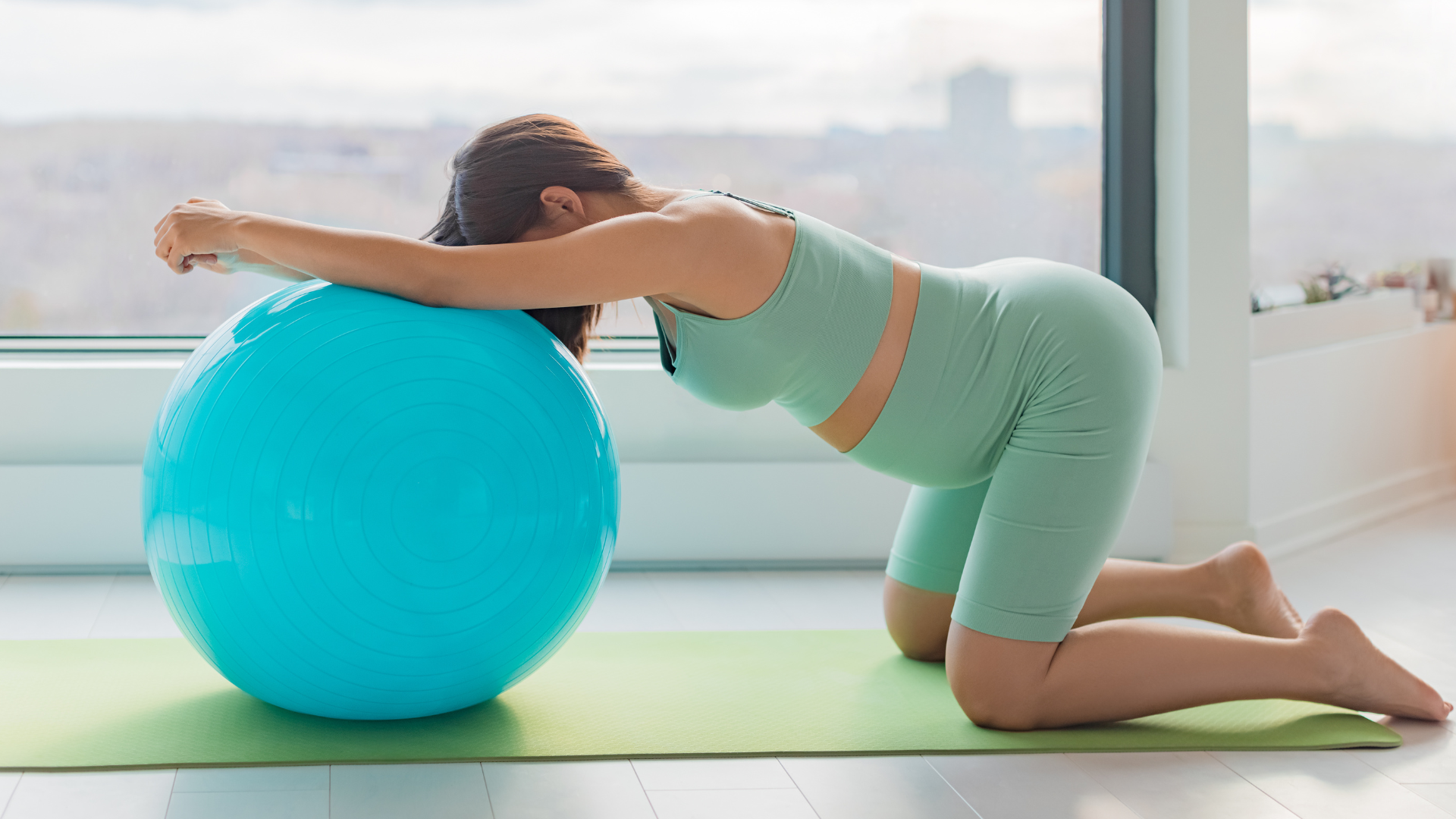Have you ever wondered if a yoga ball can actually make pregnancy more comfortable? For many moms, it becomes more than just a piece of exercise equipment.
A yoga ball isn’t just about movement; it also supports relaxation, balance, and even preparation for labor. The right ball size and simple yoga ball pregnancy exercises can make a big difference in how you feel each day.
In this blog, I’ll cover everything you need to know, from choosing the right ball to safe exercises, posture tips, and even how it can help after delivery.
What is a Pregnancy Ball?
A pregnancy ball, also called a birthing ball, is a large inflatable ball used during pregnancy and labor. It looks similar to a yoga or exercise ball but has some key differences.
A standard yoga or exercise ball is designed for workouts and stretching, while a birthing ball is made with extra thickness and anti-burst material to provide better safety and support for expectant mothers.
Using a pregnancy ball during pregnancy can improve comfort, mobility, and posture. It supports the body as it changes and can also help prepare for labor. Many women find it useful both in daily life and during delivery.
Benefits of pregnancy ball exercises:
- Improves posture and reduces back strain
- Relieves pressure on hips and pelvis
- Helps keep joints loose and reduces stiffness
- Encourages the baby into an optimal birthing position
- Strengthens stability and coordination
- Activates core muscles that support the spine
- Promotes relaxation and reduces stress
- Improves circulation and lowers swelling in legs and feet
How to Choose the Right Yoga Ball Size
The right ball size depends on your height. When seated, your knees should be level with or slightly lower than your hips.
| Your Height | Recommended Ball Size | Best Use During Pregnancy |
|---|---|---|
| Under 5’0” (152 cm) | 45 cm ball | Gentle sitting support, hip mobility, light stretching. |
| 5’1” – 5’7” (155–170 cm) | 55 cm ball | Daily sitting to relieve back pain and improve posture. |
| 5’8” – 6’1” (173–185 cm) | 65 cm ball | Core and pelvic exercises, comfort while sitting. |
| Over 6’2” (188 cm+) | 75 cm ball | Wider hip support, comfortable seating position. |
Best Yoga Ball Pregnancy Exercises
A yoga ball can ease discomfort, improve posture, and prepare your body for labor. These exercises are safe and effective when done with care.
1. Gentle Bouncing
This simple move is often the first exercise moms try on the ball. It’s easy, relaxing, and can be done daily for comfort.
- Instructions: Sit tall with feet flat on the floor, hip-width apart. Place your hands on your thighs and bounce lightly in a steady rhythm.
- Safety Tip: Keep movements slow and controlled to avoid losing balance
- Reps/Duration: 1–2 minutes at a time.
- Best Time to Use: Anytime during pregnancy, especially in the third trimester.
- Benefit: Relieves back pressure, boosts circulation, and calms nerves.
2. Hip Circles
Hip circles keep your joints loose and ease stiffness as your body changes. They also support flexibility, which is useful for labor.
- Instructions: Sit upright with feet wide for balance. Roll hips in wide circles clockwise, then counterclockwise.
- Safety Tip: Keep feet firmly planted and movements smooth.
- Reps/Duration: 8–10 circles each way.
- Best Time to Use: Second and third trimester.
- Benefit: Loosens hips, reduces stiffness, and helps baby positioning.
3. Pelvic Tilts
This move strengthens the back and pelvis while promoting alignment. It’s especially helpful if you spend long hours sitting.
- Instructions: Sit with feet flat. Tilt pelvis forward (tuck tailbone), then backward (arch lower back).
- Safety Tip: Relax your shoulders and avoid straining the back.
- Reps/Duration: 10–12 tilts per set.
- Best Time to Use: Any trimester.
- Benefit: Strengthens lower back, improves alignment, eases pain.
4. Wall Squats with Ball
Squats build strength for labor, and using the ball gives added support. This exercise also helps protect your joints as your belly grows.
- Instructions: Place the ball between your lower back and the wall. Step forward slightly, bend knees into a squat, then push back up.
- Safety Tip: Don’t let knees go past toes; move slowly.
- Reps/Duration: 8–10 squats.
- Best Time to Use: Second trimester, when energy is higher.
- Benefit: Builds leg and pelvic strength, prepares for labor.
5. Seated Marching
This exercise gently works your core while improving circulation. It’s a safe way to stay active without putting strain on your joints.
- Instructions: Sit tall, engage core, lift one knee, lower, then switch sides in a marching rhythm.
- Safety Tip: Hold onto a chair or wall if balance feels shaky.
- Reps/Duration: 1–2 minutes.
- Best Time to Use: First and second trimester.
- Benefit: Improves balance, strengthens core, boosts circulation.
6. Supported Child’s Pose
A calming position that stretches your back and hips. It’s perfect for relaxation and gentle release after a long day.
- Instructions: Kneel with the ball in front. Lean forward, drape arms and chest on the ball.
- Safety Tip: Keep knees wide to allow room for your bump.
- Reps/Duration: Hold 30–60 seconds, repeat 2–3 times.
- Best Time to Use: Any trimester, especially for relaxation.
- Benefit: Relieves back tension, opens hips, calms the mind.
7. Cat-Cow Stretch on Ball
This stretch eases stiffness and supports spinal health. It’s especially useful for posture changes during pregnancy.
- Instructions: Kneel with forearms on the ball. Inhale and arch back (cow), exhale and round back (cat).
- Safety Tip: Move slowly and avoid overextending.
- Reps/Duration: 6–8 rounds.
- Best Time to Use: Any trimester.
- Benefit: Improves spine flexibility, eases stiffness, supports posture.
8. Seated Side Stretch
As your bump grows, your ribs and torso can feel tight. This stretch helps open up space and ease discomfort.
- Instructions: Sit tall with feet flat. Raise one arm overhead and lean to the opposite side. Switch sides.
- Safety Tip: Don’t overstretch; move gently.
- Reps/Duration: Hold 15–20 seconds each side, repeat twice.
- Best Time to Use: Second and third trimester.
- Benefit: Stretches the torso, reduces rib tightness, and improves posture.
9. Rocking Forward and Back
A gentle rocking motion soothes tension in the pelvis. It’s also a helpful move to prepare for labor.
- Instructions: Sit with feet apart. Gently rock hips forward and back while keeping spine straight.
- Safety Tip: Keep movements small to avoid losing balance.
- Reps/Duration: 1–2 minutes.
- Best Time to Use: Late pregnancy or early labor.
- Benefit: Relieves pelvic tension, eases back discomfort, aids labor prep.
Safety Do’s and Don’ts
Following basic safety rules makes yoga ball exercises safer and more effective during pregnancy. Keep these simple do’s and don’ts in mind:
| Do’s | Why It Matters | Don’ts | Why to Avoid |
|---|---|---|---|
| Use an anti-burst ball | Designed to slowly deflate if punctured, making it safer. | Avoid slippery floors | A smooth floor increases the risk of slipping or falling. |
| Keep knees at a 90° angle | Ensures proper posture and reduces strain on hips and joints. | Don’t overstretch joints | Overextending can cause injury, especially with relaxed pregnancy ligaments. |
| Support balance near a wall | Provides extra stability if you feel wobbly. | Don’t push through pain | Pain is a warning sign; stop immediately to prevent injury. |
| Breathe steadily | Supports oxygen flow and keeps your body relaxed. | Don’t hold your breath | Holding breath increases tension and may reduce oxygen for you and your baby. |
| Wear non-slip socks or shoes | Improves grip and prevents slipping during movements. | Don’t use the ball barefoot on smooth ground | Bare feet may slip easily, especially on polished floors. |
Conclusion
A pregnancy ball can be more than just a support tool; it’s a way to stay active, reduce discomfort, and prepare your body for labor with confidence.
Beyond posture and mobility, it encourages relaxation and helps you stay connected to your body as it changes. The key is choosing the right size, practicing safe movements, and listening to your body’s signals along the way.
By using the ball with care, you’ll gain both physical relief and peace of mind throughout pregnancy.
If you’re ready, try adding a few of these exercises to your routine and see the difference for yourself, and share it with other moms-to-be who might benefit too.










